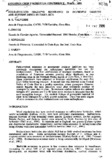Field-evolved imazapyr resistance in Ixophorus unisetus and Eleusine indica in Costa Rica
Description
4 tab. 7 ref. Sum. (En)
Résumé
Field-evolved resistance to acetolactate synthase inhibitors has been previously documented for sulfonylurea herbicides but not for imidazolinones. The first confirmation of imazapyr resistance, found in populations of Ixophorus unisetus growing along ditchbanks in rice producing areas in the Northern Pacific Region of Costa Rica, is described. These populations were subjected to imazapyr applications for over five years before becoming resistant. A second case was detected in the Central Valley of Costa Rica in a poultry operation, where goosegrass (Eleusine indica) became the most prevalent weed after continuous overuse of imazapyr for more than 4 years. Screenhouse studies indicate that selected biotypes of I. unisetus are 5 to 80 times more resistant to imazapyr than the most susceptible biotype. The resistant biotype of goosegrass required 14 times more imazapyr for a 50 per cent growth reduction. There was some degree of cross resistance to other imidazolinones and some sulfonylureas.
Keywords
Éditeur
Brighton Crop Protection Council, Surrey (RU)
Collections
- Publicaciones y documentos [4416]


